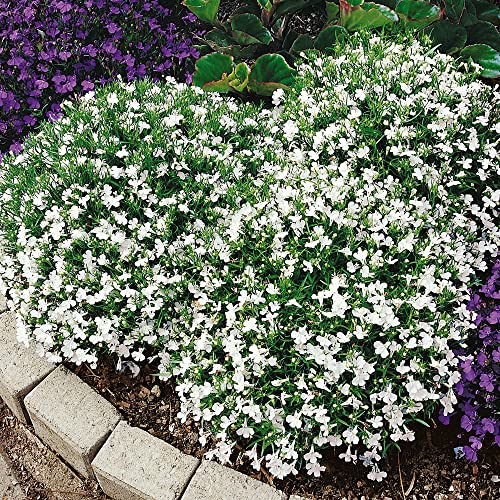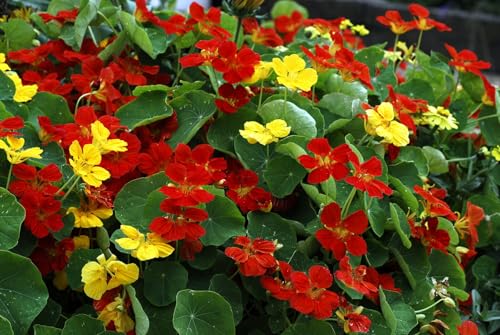I’m going to be honest – I’ve made some big mistakes when growing columbines (Aquilegia) in my garden. In fact I’ve killed off a lot of them over the years, mainly due to planting them with the wrong neighbors.
I had this silly assumption I could plant columbines anywhere and with anything. That approach led to some spectacular failures that taught me valuable lessons about what not to plant with these charming perennials.
Understanding Columbine
Columbines are woodland plants that prefer partial shade and well-draining, moderately fertile soil. They’re not the most demanding plants in the garden but pair them with the wrong neighbors and they’ll struggle to thrive or even survive. The wrong companion choices can lead to stunted growth, fewer flowers, increased disease problems and shorter lifespans for your columbines.
So you don’t make this mistakes I made I’ve put together this list of plants that just don’t play well with columbines.
Plants to Avoid Planting with Columbine
1. Aggressive Spreading Perennials
The first time I planted columbines near my beautiful stand of bee balm (Monarda) I thought I was creating the perfect spot for pollinators. Within two seasons the aggressive bee balm had completely overtaken my delicate columbines, shading them out and stealing all their resources.
Other aggressive spreaders to keep away from your columbines include:
- Mint family plants (obviously actual mint, but also many salvias and catmint)
- Gooseneck loosestrife (Lysimachia clethroides)
- Certain varieties of asters
- Obedient plant (which is ironically not obedient at all)
These plants will quickly crowd out columbines with their strong growth. I’ve since learned to keep my columbines in areas where they don’t have to compete with garden thugs.
2. Tall, Dense Shade-Creators
I once had the brilliant idea of planting columbines beneath a stand of Joe-Pye weed (Eutrochium). By midsummer my columbines were stretching and straining toward what little light they could find, resulting in weak, leggy growth and few flowers.
Other plants that create too much shade for columbines include:
- Tall ornamental grasses like Miscanthus
- Dense shrubs like mature hydrangeas
- Towering perennials like hollyhocks and delphiniums when planted too close
While columbines appreciate partial shade, especially in hot climates, they still need adequate light to flower well. Too much shade leads to poor performance and makes them more susceptible to fungal issues.
3. Heavy Feeders
Roses and columbines might seem like a romantic pairing, but in my experience, they make terrible garden companions.
Other heavy feeders that will outcompete columbines for nutrients include:
- Dahlias
- Hibiscus
- Many vegetables, especially tomatoes and squash
Columbines prefer moderate fertility – too many nutrients can actually lead to lush foliage at the expense of flowering. When paired with plants that demand lots of fertilizer columbines either get overwhelmed by too much feeding or starved when their neighbors take all the nutrients.
4. Plants That Create Wet Conditions
One spring I planted columbines near a lush stand of ligularia, thinking they’d make good shade garden companions. By mid-summer my columbines were showing signs of root rot because ligularia needs consistently moist soil while columbines prefer soil that drains well.
Other moisture-loving plants that create conditions too wet for columbines include:
- Astilbe
- Japanese iris
- Lobelia
- Many ferns that prefer boggy conditions
While columbines need regular moisture, especially when establishing they absolutely hate sitting in waterlogged soil. Their crown and roots will quickly rot in overly wet conditions.
5. Plants That Attract Leaf Miners
Leaf miners are one of the few pests that regularly bother columbines, creating horrible tunnels through the foliage. I’ve found that when I plant columbines near spinach or chard in my vegetable garden, the leaf miner problem gets much worse.
Other plants that can increase leaf miner issues for columbines include:
- Beets
- Nasturtiums
- Some chrysanthemums
While the damage is usually cosmetic rather than fatal, heavy infestations can weaken the plants over time. I’ve learned to keep my columbines away from vegetables that attract these pests.
6. Very Drought-Tolerant Plants
The mixed border where I paired columbines with lavender and Russian sage was a disaster waiting to happen. The drought-tolerant Mediterranean herbs thrived in the hot, dry conditions that left my columbines wilting and struggling.
Other drought-lovers that create conditions too dry for columbines include:
- Sedum
- Yarrow
- Lamb’s ears
- Many ornamental sages
While established columbines have some drought tolerance they much prefer consistent moisture, especially during hot weather. The cultural requirements are just too different for successful cohabitation.
7. Plants Susceptible to Powdery Mildew
One summer I noticed that the columbines I’d planted near my phlox were developing powdery mildew much earlier and more severely than columbines elsewhere in the garden. It turns out that plants prone to powdery mildew can increase the disease pressure on nearby columbines.
Other mildew-prone plants to keep away from columbines include:
- Monarda (bee balm)
- Zinnias
- Cucurbits like squash and cucumbers
- Some roses
While good air circulation helps prevent mildew issues I’ve found it’s best to avoid creating disease hot spots by keeping mildew-prone plants separate from columbines.
8. Plants That Need Frequent Division
I once interplanted columbines with daylilies thinking they’d make good companions. The problem arose when my daylilies needed division – digging them up disturbed the columbines’ roots, which they absolutely hate.
Other plants requiring frequent division that can disturb columbines include:
- Iris
- Shasta daisies
- Certain hostas
Columbines develop a taproot and resent being disturbed once established. Planting them among perennials that need regular digging and dividing inevitably leads to damaged columbine roots.
9. Plants That Create Intense Root Competition
The columbines I planted near my established maple tree never thrived despite the perfect dappled shade. The tree’s root system simply took up too much water and nutrients.
Other plants creating too much root competition include:
- Shallow-rooted trees like birch
- Bamboo
- Aggressive groundcovers like pachysandra
Columbines need access to soil resources without battling established root systems. I’ve found they do much better when given their own root space even if they’re sharing above-ground space with other plants.
10. Plants That Need Significantly Different Soil pH
Try growing columbines near something like a blueberry bush. The acidified soil you need for the blueberries (pH around 4.5-5.5) will be too low for the columbines, which prefer slightly acidic to neutral soil.
Other plants requiring soil too acidic for columbines include:
- Rhododendrons and azaleas
- Camellias
- Heathers
But alternatively extremely alkaline-loving plants like many Mediterranean herbs create conditions that aren’t ideal for columbines either. It all gets a bit awkward and annoying!
11. Plants That Are Allelopathic
If you don’t know about juglone, the chemical black walnut trees (amongst others) produce that inhibits growth in many plants, it’s a total death trap for columbines.
These plants release natural chemicals that can inhibit the growth of their neighbors – a gardening complication I wish I’d known about sooner!
Other plants with allelopathic effects that may impact columbines include:
- Sunflowers
- Some eucalyptus
- Tree of heaven
Good Companion Plants for Columbine
After all those no-nos I wouldn’t blame you for thinking nothing can be grown with columbines. Thankfully there are some companions I’ve found work well:
- Woodland Phlox (Phlox divaricata) – Lower growing and less prone to mildew than its taller cousins
- Hardy Geraniums – Especially varieties like ‘Johnson’s Blue’ that share similar cultural requirements
- Coral Bells (Heuchera) – Their colorful foliage complements columbines perfectly
- Foamflower (Tiarella) – Another great woodland companion
- Small Hostas – Provide beautiful foliage contrast without overwhelming columbines
- Spring Bulbs – Daffodils, tulips, and alliums bloom before columbines hit their stride
- Ferns – Especially the more drought-tolerant varieties like autumn fern
Tips for Successful Companion Planting with Columbine
- Match water needs – Choose companions that prefer moderate moisture and good drainage
- Consider bloom times – Plants that bloom sequentially with columbines create a longer season of interest
- Respect root space – Give columbines room to develop their taproot without excessive competition
- Plan for self-sowing – Columbines self-seed readily; choose companions that won’t be overwhelmed by volunteer seedlings
- Create microclimates – In hot regions, use taller plants to provide afternoon shade for columbines
Final Thoughts
Columbines are among my favorite garden perennials. But from a lot of growing them I’ve learned that their easygoing nature doesn’t extend to tolerating all garden companions.
The right planting partners can highlight columbines’ lovely qualities. The wrong companions can lead to struggling plants and garden disappointment.
I hope my mistakes and successes help you create better growing conditions for these woodland beauties in your own garden. With a little planning and the right neighbors your columbines will thrive.






